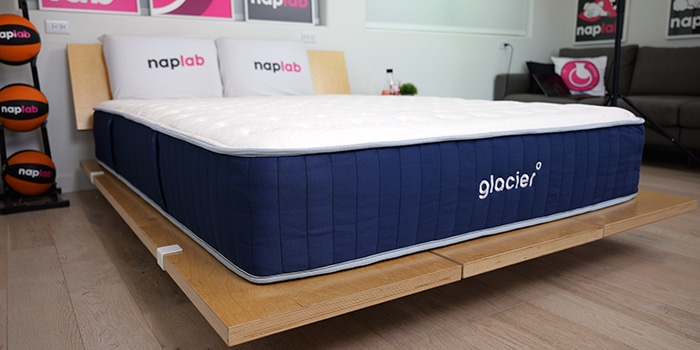
Best For
- Great value—9% less expensive than the average memory foam hybrid
- Best memory foam hybrid tested to date (above average performance in 6 out of 10 categories)
- Particularly impressive pressure relief and edge support performance
Considerations
- Low bounce is not great for sex performance
- Slower than average material response time
- 14″ thickness may not pair well with a thick foundation if you’re looking for a low-profile aesthetic
Our Verdict
The Glacier Apex is a 14.25″ memory foam hybrid mattress with a comfort layer of copper memory foam, a 2.0″ memory foam core, transitional poly foam, and a pocketed coil base.
This mattress has moderate levels of sinkage and low levels of bounce, a pretty traditional feel for memory foam hybrids.
It is available in a single firmness, 6 out of 10, with a medium-firm feel.
In our performance tests, the Glacier Apex earned an impressive overall performance score of 9.27, ranking the Apex in the top 8% of all mattresses tested to date.
Concerning price, this mattress costs $1,399 for a queen mattress, which 9% less than the average memory foam hybrid mattress (a savings of $133). To date, the Glacier Apex is the highest-performing memory foam hybrid we’ve tested to date and yet the price still falls below the average, making it the mattress to beat.
Type: Memory Foam Hybrid
Firmness: Medium-Firm (6)
Best For: All Sleeping Positions, All Body Weights
In This Review
Performance Tests | Firmness | Support & Sleeping Positions | Design | Materials | Comparisons | FAQs
Performance Tests
At NapLab, we put each mattress to the test.
We test 10 different factors that impact the performance, comfort, and feel of the mattress. We then take the results of that test and compare to every mattress we’ve tested to date.
Check out the full performance table below to see how this mattress ranks:
| Factor | Glacier Apex | Average |
|---|---|---|
| Overall Score | 9.27 | 8.55 |
| Price (Queen) | $1,399 | $1,532 (Memory Foam Hybrid only) |
| Cooling – Score | 9.0 | 8.6 |
| Sinkage – Depth | 2.14″ | 2.15″ |
| Sinkage – Feel | Moderate | Moderate |
| Motion Transfer – Score | 9.7 | 8.2 |
| Motion Transfer – Acceleration | 5.77 m/s² | 8.74 m/s² |
| Response Time – Score | 8.4 | 8.9 |
| Response Time – Mostly Recovered | 0.4 sec. | 0.4 sec. |
| Response Time – Fully Recovered | 1.2 sec. | 1.0 sec. |
| Bounce – Height | 6.02″ | 9.38″ |
| Bounce – Feel | Low | Moderate |
| Edge Support – Score | 9.9 | 8.6 |
| Edge Support – Sitting | 3.25″ | 4.06″ |
| Edge Support – Lying | Outstanding | Good |
| Sex – Score | 7.4 | 8.4 |
| Pressure Relief – Score | 10 | 8.7 |
| Comfort Layer Thickness | 6.25″ | 4.1″ |
| Mattress Thickness | 14.25″ | 12.0″ |
| Off-Gassing – Score | 8.9 | 8.2 |
| Off-Gassing – Smell | Strong | Strong |
| Off-Gassing – Days | 4 days | 6 days |
| Company – Score | 10 | 8.6 |
| Trial | 365 nights | 177 nights |
| Warranty | Lifetime | 26% have lifetime warranties, average of other 74% of mattresses is 13 years |
How is Glacier Apex Different?
The Glacier Apex is the highest-performing memory foam hybrid tested to date with above-average performance paired with a below-average price, 9% less expensive than the average memory foam hybrid. For an absolute slam-dunk value, it’s hard to beat that of the Glacier Apex.
Advantages
Performance advantages of the Glacier Apex include above-average cooling, low levels of motion transfer (34% less motion than the average mattress), and outstanding edge support. The 14.25″ profile is also a contributing factor to the exceptional pressure relief offered by the Apex.
Other smaller advantages include faster off-gassing as well as a longer trial and lifetime mattress warranty.
Neutral Factors
This mattress has moderate levels of sinkage and low levels of bounce. This is pretty typical of a memory foam hybrid and about what we’d expect from a mattress in this category.
Disadvantages
The only real disadvantage of the Apex is a slower material response time. Some sleepers may find the low bounce to also be a disadvantage, as it negatively affects the sex performance score, but if you’re looking for a traditional memory foam feel, low bounce is an expected feel of this mattress type.
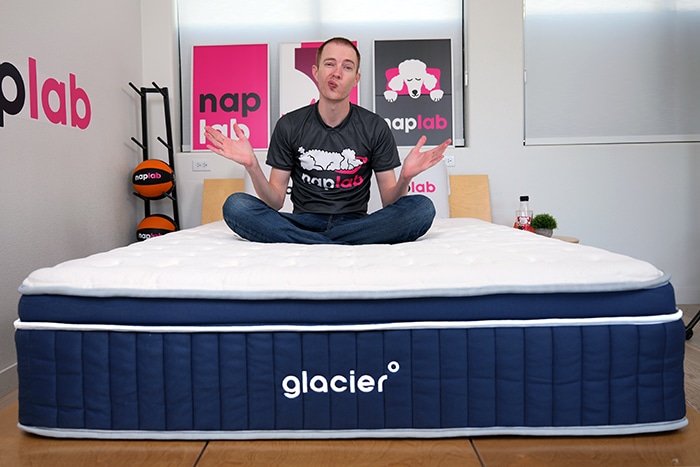
Cooling Test
The Glacier Apex has excellent cooling. During our tests, I felt no notable level of heat retention around my body. The mattress remained comfortably cool during the entirety of our cooling tests.
Baseline Temp.
77.2° F
Max Temp.
89.1° F
Ending Temp.
81.1° F
The mattress is equipped with a cooling cover that creates a cool-to-the-touch feel. The cover definitely has a cooler feel and even at the end of our tests, the cover felt cool, though not quite as cool as it did initially.
According to GlacierSleep’s website, the Apex uses a more advanced cooling cover compared to the less expensive Glacier Original. Based on our tests of both the Glacier Original and Apex, I do agree that the cooling cover on the Apex feels higher performance and cooler than the cover on the Original.
Max Temp.
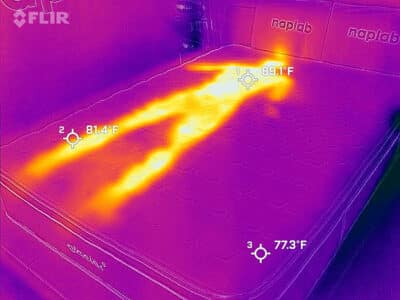
Ending Temp
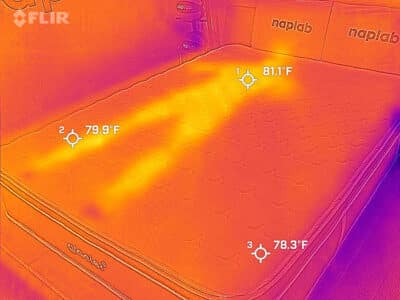
- Baseline Temperature – the temperature of the mattress before anyone lies on it
- Maximum Temperature (0 minute) – the temperature of the mattress after lying on it for 15 minutes
- Ending Temperature (5 minute) – the temperature of the mattress after being lied upon and having no one on it for 5 minutes
In addition to the cooling cover, the mattress benefits from the breathability afforded to it by the pocketed coil support layer. Lastly, all foam layers look and feel high quality and the gel with the memory foam layer is further helping to manage heat issues.
In our objective temperature tests, we measured a max surface level temperature of 89.1° F. This is 0.6° less than the average of 89.7° F, based on all of our tests to date.
After getting off the mattress the temperature declined by 4.8° from minutes 0 to 1, which is 0.1° cooler than the average 0 to 1 minute decline of 4.7°.
Heat Dissipation Over Time
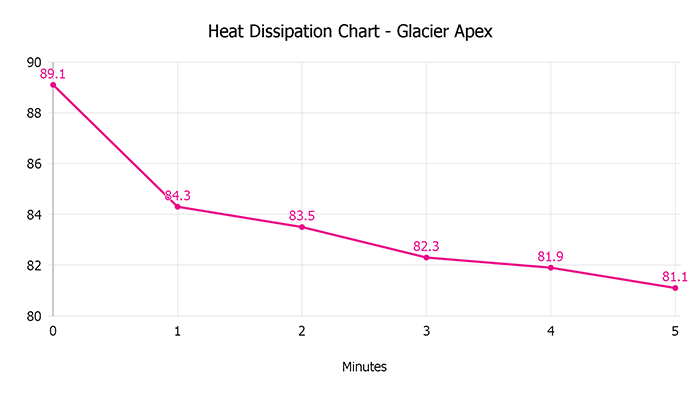
When we consider the combination of objective data, my subjective experiences, and an analysis of the materials, I’m confident in my view that cooling is excellent.
Sinkage Test
The Glacier Apex has moderate sinkage. During our tests, we measured a pressure point sinkage depth of 2.14″. This is 0.01″ less sinkage than the average sinkage depth of 2.15″, based on all of our tests to date.
Sinkage Depth
2.14″
Sinkage Feel
Moderate
The level of sinkage is documented in the image below.
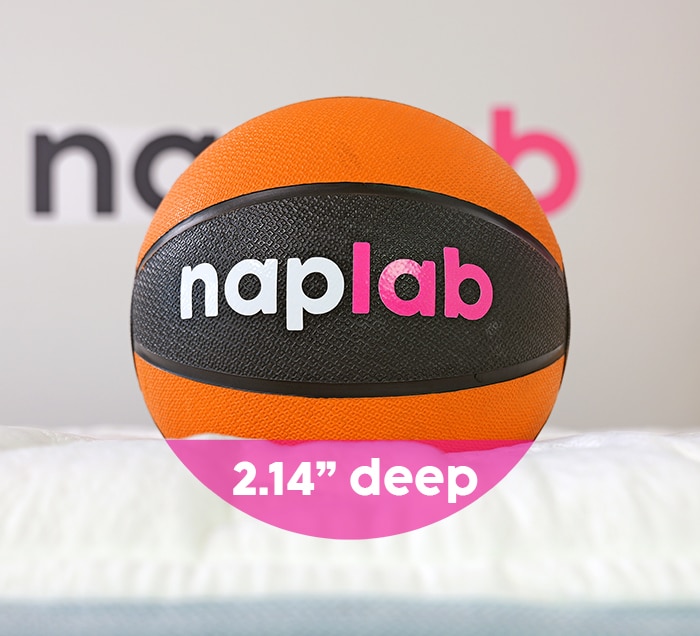
The mattress creates a more dramatic contouring hug around the body. This mattress uses 3.0” of memory foam within the comfort layer. This gives the mattress its more significant contouring feel.
That said, the foams are still highly responsive, especially relative to more traditionally formulated memory foams. As a result, you never feel “stuck” or overly enveloped by the materials and it remains easy to move around on, change positions, and get in / out of bed.
Motion Transfer Test
The Glacier Apex has a very low level of motion transfer. During our tests, we measured a total acceleration range of 5.77 m/s². This is 34% less motion transfer than the average of 8.74 m/s².
Max. Acceleration
2.59 m/s²
Min. Acceleration
-3.18 m/s²
Accel. Range
5.77 m/s²
The thick 6.25” comfort layer, gel memory foam, and pocketed coil support are all helping to mitigate motion. However, the most significant factor keeping motion held to a minimum is the low level of bounce.
At 6.02” of bounce the Apex has notably less bounce than average. That lower bounce simply means there is less energy that’s able to return to the surface of the mattress as motion.
The level of motion transfer is also documented in the video below.
In our motion transfer chart, which visualizes our accelerometer data, we can see the highest motion peaks from 0 to 0.14 seconds.
Immediately thereafter motion declines and by 0.58 seconds we’ve returned to near-zero levels of energy.
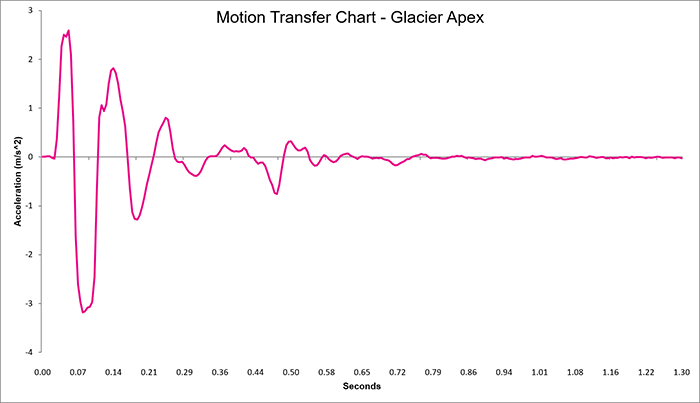
Overall, I’m extremely pleased with the level of motion. But the motion duration and motion intensity are well below average. As a result, I don’t expect motion transfer will be problematic for most sleepers.
Response Test
The Glacier Apex is a mixed bag for material responsiveness, with a fast mostly recovered response time and a moderate fully recovered response time.
Mostly Recovered
0.4 sec.
Complete Recovery
1.2 sec.
In our mostly recovered test, we measured a recovery speed of 0.4 seconds, which is 0.02 seconds faster than the average of 0.42 seconds, based on all of our tests to date.
In our fully recovered responsiveness test, we measured a recovery speed of 1.2 seconds, which is 0.24 seconds slower than the average of 0.96 seconds. The Apex uses 3.0” of memory foam.
While those memory foam layers have a faster material responsiveness than more traditionally formulated memory foam, they are still not as fast as many other types of poly foam or latex. As a result, it takes the mattress a couple of extra moments to fully reform back to its original shape.
The level of responsiveness is documented in the video below.
While a faster responsiveness would have been better, I am not overly concerned with these responsiveness speeds. The mostly recovered time is still faster than average and the fully recovered time is only slightly worse than average.
When we consider this alongside the moderate sinkage depth, I expect most sleepers will find these response speeds to be acceptable.
Bounce Test
The Glacier Apex has a low level of bounce. During our tests, we measured a total bounce height of 6.02″. This is 3.39″ less bounce than the average of 9.41″, based on all of our tests to date.
Max. Depth
4.38″
Max. Rebound
1.64″
Total Bounce
6.02″
Max. Sinkage Depth
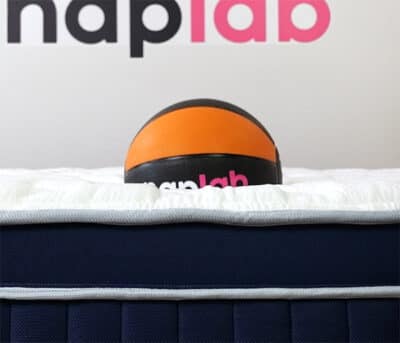
Max Bounce Height
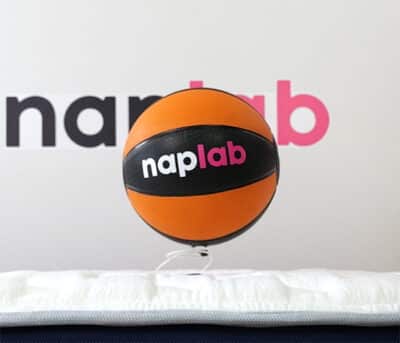
The level of bounce is also documented in the video below.
The lower-than-average bounce is primarily the result of the 1.0” copper memory and 2.0” gel memory foam layers. This type of memory foam greatly absorbs and reduces energy, which means bounce is more restrained.
Even so, given the moderate sinkage depth, bounce is still sufficient enough to provide for ease of movement.
The lower bounce also greatly helps to reduce motion transfer. The one area where bounce is a problem is sex performance. Lower bounce almost always means worse sex performance and that’s exactly what we see on the Apex.
Edge Support Test
The Glacier Apex has excellent sitting edge support and outstanding lying edge support. In our sitting edge support test, we measured a sitting sinkage compression of 3.25″. This is 0.80″ less sitting sinkage than the average of 4.05″, based on all of our tests to date.
Max Sinkage
3.25″
Lying Support
Outstanding
While sitting directly on the edge of the mattress I felt that support was robust and there was no collapse of materials. The same materials, design, and edge coils that enable the fantastic sitting edge support also create amazing support for lying.
The level of edge support while seated is documented in the images below.
Sitting, 140 lbs.

Sitting, 200 lbs.

While lying directly on the edge of the mattress, I felt that the support was outstanding in all sleeping positions. The Glacier Apex uses 2 rows of reinforced coils along the left and right sides of the mattress. These coils are especially impressive.
The level of edge support while lying is documented in the images below.
Lying on Edge, 140 lbs.
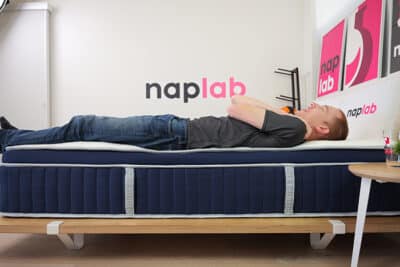
Lying on Edge, 200 lbs.
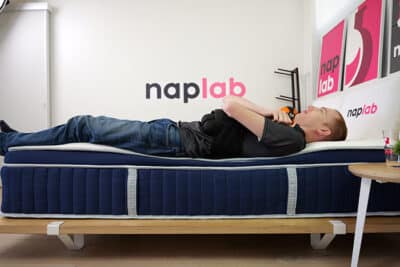
It’s not uncommon for a hybrid mattress with perimeter-reinforced coils to earn a good or excellent score for edge support. However, it’s far more rare to see a mattress reach our threshold for an outstanding score. Nevertheless, the Glacier Apex earned it and the lying edge support feels incredibly robust. One note to consider is that the reinforced coils exist only along the left and right sides of the mattress.
The head and foot of the mattress does not have reinforced edge support coils and therefore it has worse edge support compared to the left and right sides of the mattress.
Having reinforced coils run all the way around the mattress perimeter is definitely better, but only having them on the left and right sides does help to reduce the cost, while still providing the biggest impact while you’re actually sleeping
Sex Test
The Glacier Apex has fair sex performance. On the positive side, noise is minimal, cooling is excellent, pressure relief is outstanding, and edge support is also excellent. With just 3.25” of sitting edge sinkage, the edge is incredibly robust.
| Sex Factor | Factor Weight | Score | Rating |
|---|---|---|---|
| Bounce | 65% | 6.2 | Low |
| Edge Support | 20% | 9.7 | Excellent |
| Noise | 5% | 10 | Minimal |
| Pressure Relief | 5% | 10 | Outstanding |
| Cooling | 5% | 9.0 | Excellent |
This creates a larger area for amorous activities and may be of significant importance to you and your partner’s dance without pants. The one area where the mattress leaves much to be desired for sex is the bounce.
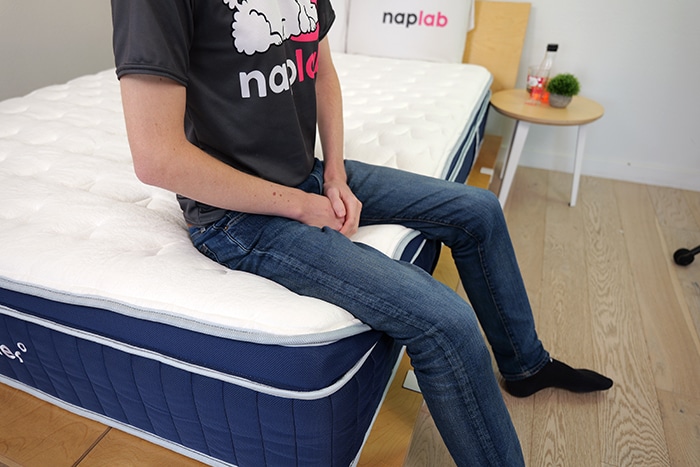
At 6.02” of bounce the Glacier Apex has a low level of bounce. Lower bounce is almost always worse for sex performance as it simply makes it more tiring and strenuous to have sex on.
Pressure Relief Test
The Glacier Apex has an outstanding level of pressure relief. During our tests, I felt no level of pressure point buildup anywhere on my body.
Comfort Layer
6.25″
Support Layer
8.0″
To the contrary, the mattress was incredibly comfortable and alleviated many areas of typical soreness in my back and body.
The mattress is equipped with 6.25″ of comfort material, which is considerably thicker than the average. The Glacier Apex has 2.1″ more comfort material than the average comfort layer thickness of 4.15″, based on all of our tests to date.
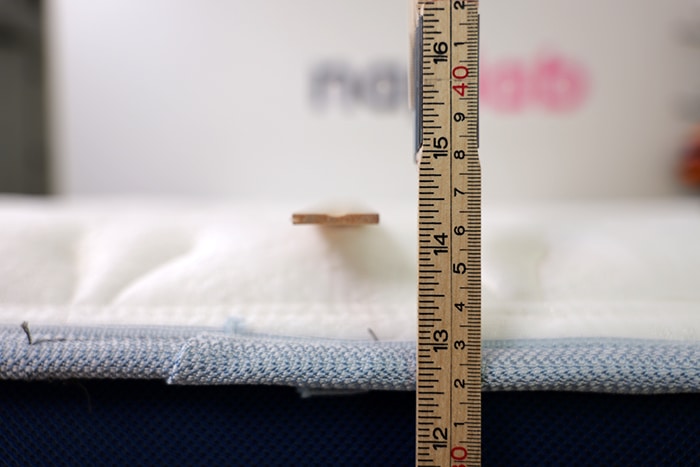
All that extra material pays huge dividends in terms of comfort and pressure relief. In addition, each of the foam layers look and feel high-quality.
In particular, the 1.0” copper memory foam and 2.0” gel memory foam work together to create ample comfort and a dramatic body contouring hug.
In our pressure mapping tests, we measured a max PSI of 0.93. A PSI at 2.0 is considered a “high” pressure point and the Apex stays well south of that.
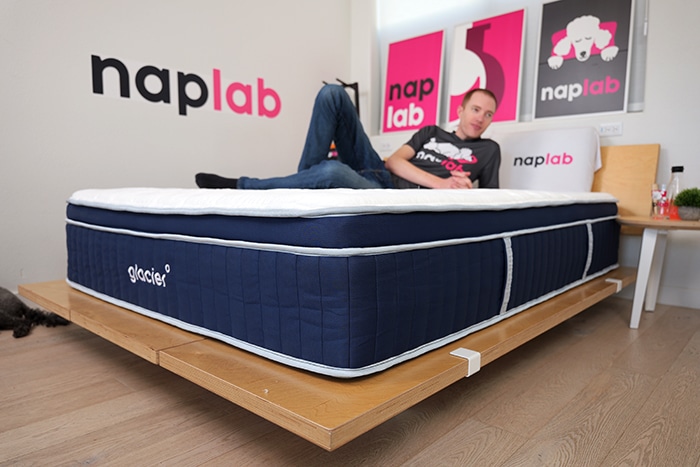
When I consider the objective pressure maps, material thickness, material quality, and my subjective experience on the mattress, I’m confident most sleepers will find the pressure relief to be outstanding.
Pressure Map – Side Sleepers
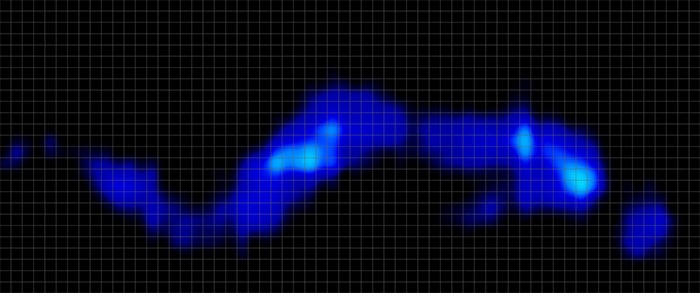
| Pressure Relief (PSI) | Average | Maximum |
|---|---|---|
| Side Sleepers | 0.16 | 0.93 |
Pressure Map – Back Sleepers
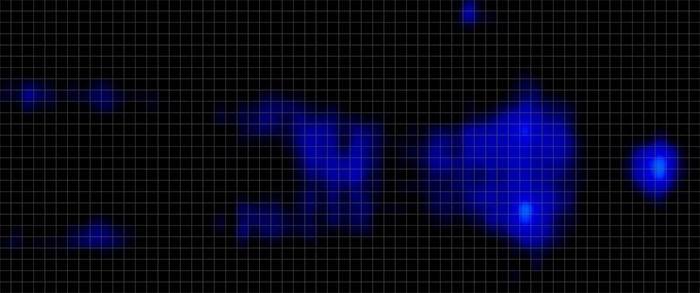
| Pressure Relief (PSI) | Average | Maximum |
|---|---|---|
| Back Sleepers | 0.08 | 0.50 |
Pressure Map – Stomach Sleepers
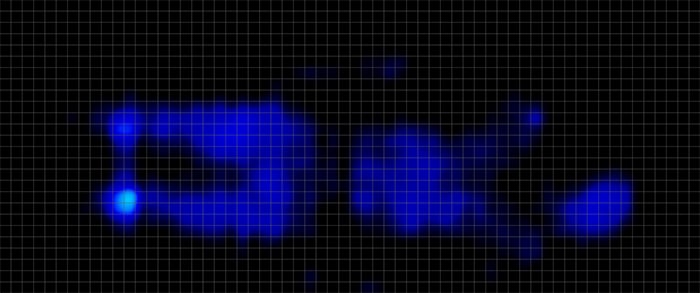
| Pressure Relief (PSI) | Average | Maximum |
|---|---|---|
| Stomach Sleepers | 0.09 | 0.81 |
Off-Gassing Test
The Glacier Apex had a strong smell upon the initial unboxing. The mattress smelled for 4 days. This is 2.4 days less than the average of 6.4 days.
Initial Smell Strength
Strong
Off-Gassing Period
4 days
The initial odor smells quite a bit like wet paint. Fortunately, the odor didn’t last long and by the end of day 4 it had effectively dissipated.

Company
The Glacier Apex comes with a 365-night trial period and a lifetime warranty. Shipping and returns are both free. Overall, this checks pretty much all of the boxes we look for in a good company.
| Company Factor | Factor Weight | Score | Data |
|---|---|---|---|
| Trial Period | 15% | 10 | 365 nights |
| Warranty | 10% | 10 | Lifetime |
| Shipping | 5% | 10 | $0 |
| Returns | 20% | 10 | $0 |
| Trust | 50% | 10 | Outstanding |
| Country of Origin | 0% | USA |
For reference, the average trial period is 177 nights, so Glacier provides an additional 188 nights to decide if it’s the right pick for you. The lifetime warranty is also longer than the 13 year average.
Considering all mattresses tested to date, only 26% of mattresses offer a lifetime warranty (approximately 1 in every 4 mattresses).
How firm is Glacier Apex?
The Glacier Apex is available in a single firmness, 6 out of 10, giving the mattress a medium-firm feel.

Support & Sleeping Positions
Support on the Glacier Apex is excellent. During our tests, I felt well-supported in all sleeping positions. The mattress is equipped with an 8.0″ support layer.
This is 0.12″ thicker than the average support layer thickness of 7.88″, based on all of our tests to date. The pocketed coil unit is not zoned. Meaning the coils have a consistent firmness, gauge, and feel.
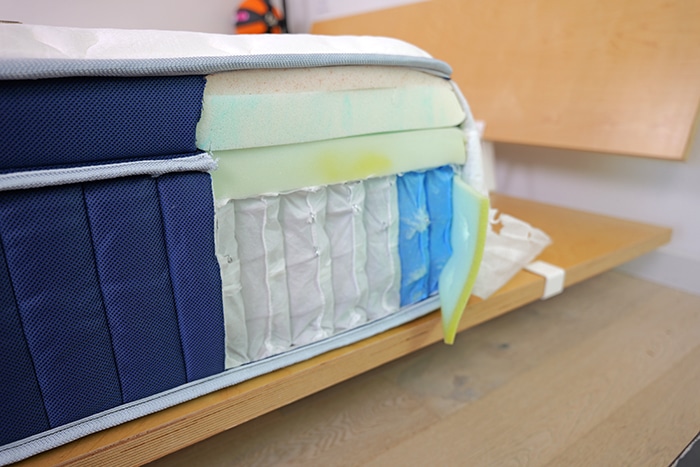
However, the mattress is equipped with an additional foam layer to create extra support in the lumbar region.
That extra foam layer, on top of a reinforced quilted cover, which also has extra lumbar support material, helps to provide a measure of zoned support, even if it doesn’t incorporate a zoned coil unit.
Zoned support creates more support where the body weighs more, which can also help to reduce sagging in the middle of the mattress. When I look at the material construction I’m incredibly pleased.
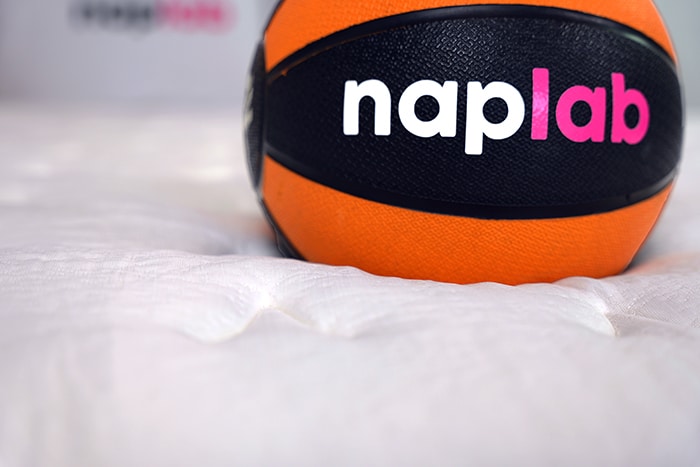
We have a quality 8.0” coil unit with 6.25” of comfort material. This ensures we have ample pressure relief, comfort, transitional support, and a robust steel coil foundation.
Based on all of my tests to date, an analysis of the materials, and my subjective experiences, I’m confident most sleepers will find support on the Glacier Apex is excellent.
Check out the table below to see the sleeper weights and sleeping positions that would be best suited for this mattress.
| Sleeper Weight | Stomach Sleepers | Side Sleepers | Back Sleepers |
|---|---|---|---|
| Under 150 lbs. | Yes | Yes | Yes |
| 150-250 lbs. | Yes | Yes | Yes |
| 250-300 lbs. | Yes | Yes | Yes |
Design
The Glacier Apex is a 14.25″ memory foam hybrid with a medium-firm feel (6 out of 10 on the firmness scale).
Type
Memory Foam Hybrid
Thickness
14.25″
Firmness
6
Glacier is a newer name in the mattress market, having just launched in 2024, but enters the scene with three solid mattresses mattresses—the Glacier Apex Hybrid, Original Hybrid, and the Summit Hybrid.
Of the three Glacier mattresses we’ve tested, the Apex Hybrid has the highest performance, but also the highest price tag.
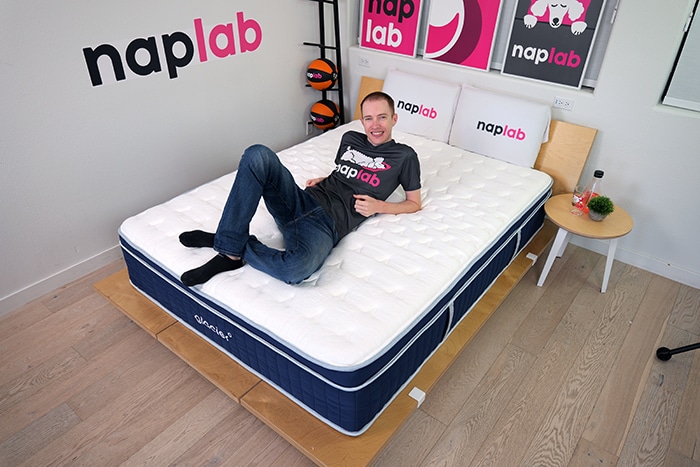
Materials
From top to bottom, there are five layers on the Glacier Apex, a combination of foam and coils. The layers include:
- 1.25” euro top cover
- 1.0” copper-infused memory foam
- 2.0” gel-infused memory foam
- 2.0” poly foam
- 8.0” pocketed coils
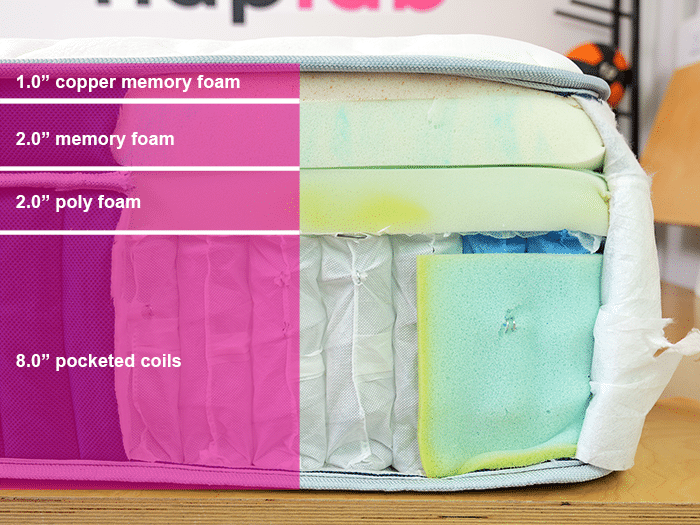
The Law Tag outlines the full breakdown of materials included in this mattress.
- Materials
- 17% polyurethane foam
- 67% Viscoelastic poly foam
- 8% Resinated Textile Pad
- 8% Blended fiber batting
- 75% Rayon
- 25% Polyester
- New innerspring unit
- Date of Delivery: 10/28/2024
- Finished Size: 60 X 80”
- Net Weight of Filling Mat: Not Listed
- Made in USA
- Manufactured By: I.S.P 3535 W. 47th Street Chicago, IL 60632
- Date of Manufacture: 10/2024
- Model: 244M-5R
The Cover
The Glacier Apex has a plush Euro pillowtop cover. It is soft to the touch and has cooling properties that give the mattress a cool feel and offsets and natural heat retention properties of memory foam.
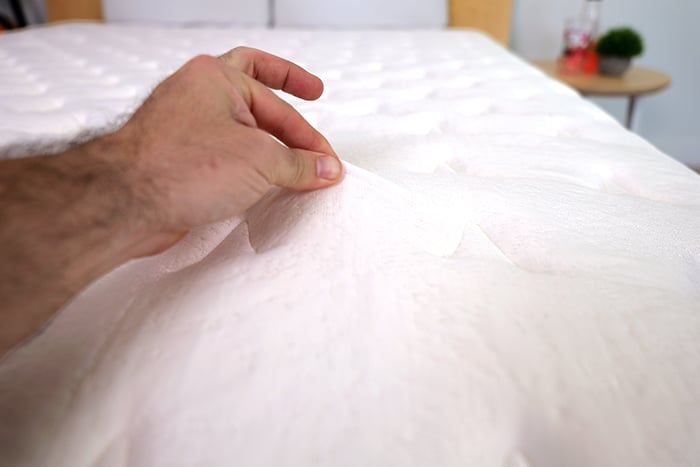
The Comfort Layer
Beneath the cover is a dynamic comfort layer of three different foams. At the top, we see a 1.0″ copper-infused memory foam followed by a 2.0″ gel-infused memory foam.
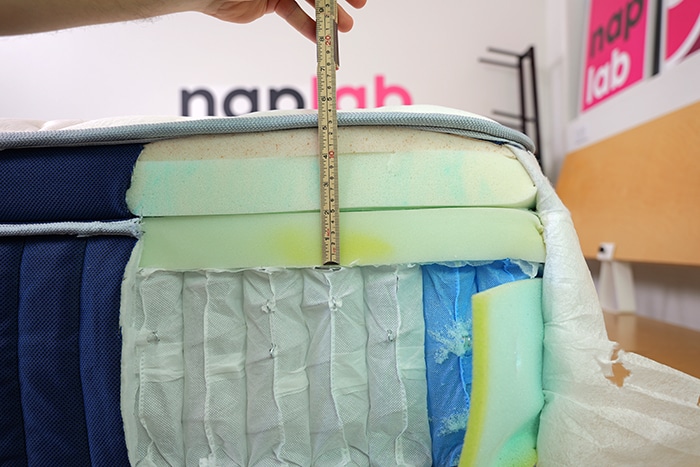
The last foam is a 2.0″ poly foam which acts a bit like a transitional layer between comfort materials and the support layer below.
The Support Layer
The support layer is an 8.0″ pocketed coil base with reinforced edges only on the sides of the mattress (not at the head or foot). Reinforced coils are encased with a thin blue fabric and regular coils are encased in a white fabric.

Product Evolution
The Glacier Apex was released in 2024. Since it hit the mattress market, the Apex has not undergone any notable changes to materials or overall design.
Other Mattresses to Consider
Not sure if the Glacier Apex is the right pick for you? Check out these three other top-rated memory foam hybrid mattresses for high-performing alternatives you may want to consider.
For Bounce

Saava Memory Foam Hybrid
9.24 Overall Score
The Saatva Memory Foam Hybrid is another high-performing memory foam hybrid. Unlike the Apex, which has moderate sinkage and low levels of bounce, the Saatva has minimal sinkagre and very high levels of bounce (2.3X more bounce than the Apex). If you’re looking for a more active feel and better sex performance, but keeping the same firmness, the Saatva is a great option to consider.
For Firmness

Bear Elite Hybrid
9.24 Overall Score
The Bear Elite Hybrid is another 14″ memory foam hybrid that also uses copper-infused memory foam, transitional poly foam, and pocketed coils at the base. This mattress comes in three firmness levels—Soft (4.5), Medium-Firm (6), Slightly Firm (7.5), making it a good option if you’re looking for something notably firmer or softer than the Apex, but at a similar price point.
For Faster Response
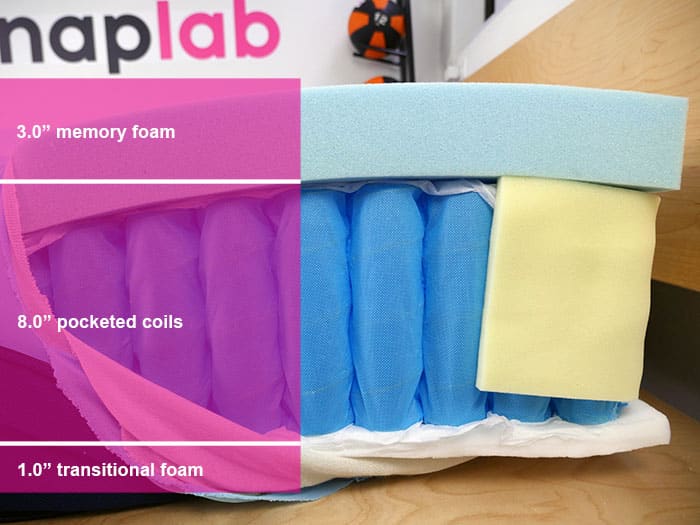
Amerisleep AS3 Hybrid
9.25 Overall Score
The Amerisleep AS3 Hybrid is a 14″ hybrid with a modern memory foam feel and a slightly faster material response time. It has great performance and is one of the best memory foam hybrids tested to date. The AS3 has a 3.0″ comfort layer with a medium feel (5 out of 10) and exceptional pressure relief. For an Amerisleep with an even softer feel (3.5 out of 10), check out the Amerisleep AS5 Hybrid.
Frequently Asked Questions
Still have questions? Check out some of the top FAQs on the Glacier Apex mattress below and get the answers you’re looking for.
Here are the current prices, with any sales or promotions reflected below:
Twin: $1,099
Twin XL: $1,299
Full: $1,299
Queen: $1,399
King: $1,799
Cal. King: $1,799
*Note: Sales prices are subject to change without notice or warning.




